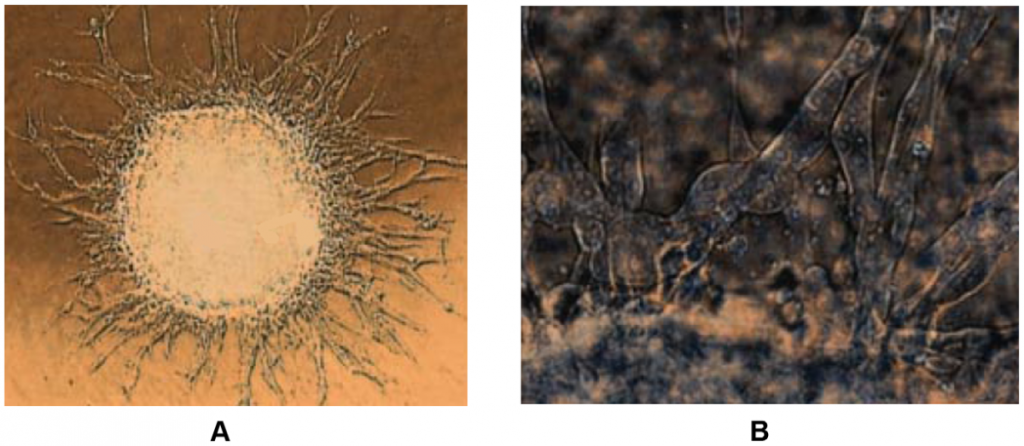First, some basic scientific theory is summarized, which will then be directly related to the problem of cancer.
Modern oncology, as just one branch of modern medicine, despite the accumulation of a huge amount of information and high tech diagnostics, is still underlying based on some very out of date ideas:
- A linear, A to B to C, understanding (ie model) of cancer formation, that is based on 19th-20th century classical Physics models.
As Niels Bohr (Nobel Prize, Physics) pointed out 50 years ago, this model does not relate well to living systems – biology, disease process, etc.
Bohr Niels. Atomic Theory and the Description of Nature. Cambridge University Press 1961, pp22-23.
Here is a simple illustration representing the conventional, linear model of cancer formation and growth:
In contrast, a different model to the linear one shown above, called, ‘General Systems Theory’, or just ‘Systems Theory’, applies much more closely to living systems, at every level of scale. Systems theory approaches are established and well developed scientific concepts in many areas of study of living systems. However, this approach has still not been applied very much to the problem of cancer.
Here is a brief explanation of some key features of systems theory:
A basic feature of a complex system, like a small group of molecules, or a whole weather system, is that it has ’emergent properties’ – that are the outcomes of the many interactions that happen between the components of that system. These emergent properties are not tied directly to any one of the many components of the system, and they can be very hard, or virtually impossible, to predict. The expression, “greater than the sum of their parts”, is often used to describe a complex system and its emergent properties.
A common example of an emergent property, is the completely unique pattern in each snowflakes (Figure 1). These patterns ’emerge’ from complex electrochemical and electromagnetic interactions, and are said to be never the same twice; even though the chemical composition of every snowflake remains basically the same.
To see how this example relates to cancerous growths, every unique snowflake can be thought of, by analogy, as representing a completely unique occurrence of a cancerous emergent property in an individual human being. It is well established, that regardless of where a cancer is found in the body, and from what kind of cell it grows from (and so what cancer classification it receives at time of diagnosis), there are big differences between one cancer and another even when classified as exactly the same.
Another common example of an emergent property, is the shape and overall movement formed by swarms of birds.

A physical shape ’emergent property’ from millions of interactions. The darker, denser part is an especially focused area where the emergent property is ‘concentrated’. The analogy is that this concentrated area represents a place where a cancer could form in a particular area of the body, where the problem(s) causing the cancer are most concentrated and are hard for the body to normalize, without outside medical help.
These explanations might sound abstracted and a long way away from the hard reality of cancers, cancer cells, and cancer growth, but the very opposite is true. For example, research done at Princeton University in the USA, shows that the Systems Theory approach and the understanding of emergent properties in fact applies very well to solid tumors and their behavior. Compare the next two sets of photos:
- In the first two photos below, A & B, a brain tumor is shown, with ‘branches’ extending into the surrounding normal tissue. Photo B is a close-up of these branches (called dendrites). This kind of cancerous tumor is usually termed “malignant” and “invasive”. These words suggest that the cancer cells are deliberately “bad” and are trying to “invade” and take over the surrounding normal cells and tissue. But this is merely a (Bronze Age) very out of date and unscientific interpretation of what is happening.
- In the next set of images below (A-D), using a Systems Theory approach, the researchers show the emergent properties (in this case, the physical shapes) of simulated, growing cancerous tumors. What they did, was calculate the emergent properties of the simulated cancer cells of a tumor as a result of the complex interactions between those cancer cells and the surrounding cells and tissues.
Notice how these calculations result in dendritic branches just as in the real photos of an actual tumor seen above in the first set of photos (A & B)!
What this research indicates, among many other ideas, is that what we might think about a cancer as seemingly consisting of “bad” and “invasive” cells, which are words that make it sound like the cancer cells are deliberately trying to do harm to their ‘host’ (the human being or other animal with the cancer), is actually simply the emergent properties of the problematic cellular microenvironments (very small anatomical dimensions). These emergent properties can also happen in unpredictable, complex ways, just like spots of complex weather patterns just happen; there is no “bad” intention of the cancer cells.

Citation: Jiao Y, Torquato S (2011) Emergent Behaviors from a Cellular Automaton Model for Invasive Tumor Growth in Heterogeneous Microenvironments. PLoS Comput Biol 7(12): e1002314. doi:10.1371/journal.pcbi.1002314
The other major understanding gained from this and other similar research, and more generally thinking about cancer using a Systems Theory approach (as explained above), is that normalizing the microenvironments of and around a cancerous tumor (‘noeplasm’) can critically influence how a cancer behaves, spreads or not, changes or does not change, and even shrinks and disappears.
To summarize:
- A cancerous growth can be understood as a result of emergent properties of problem (pathological) microenvironments.
With these better, scientific, understandings, logically, effective normalizing treatments for a cancerous growth can be developed, by making every non-destructive intervention possible to directly and indirectly correct and normalize (return to health) in detail, the problematic microenvironments, so that the emergent properties resulting in the cancerous growth reverse and disappear.
Images labelled from A-D are taken from: Jiao Y, Torquato S (2011) Emergent Behaviors from a Cellular Automaton Model for Invasive Tumor Growth in Heterogeneous Microenvironments. PLoS Comput Biol 7(12): e1002314. doi:10.1371/journal.pcbi.1002314.


